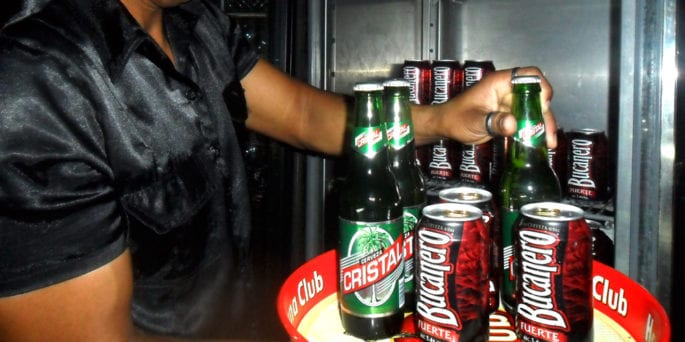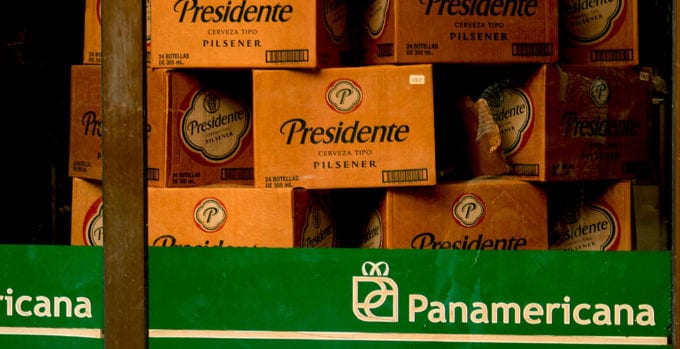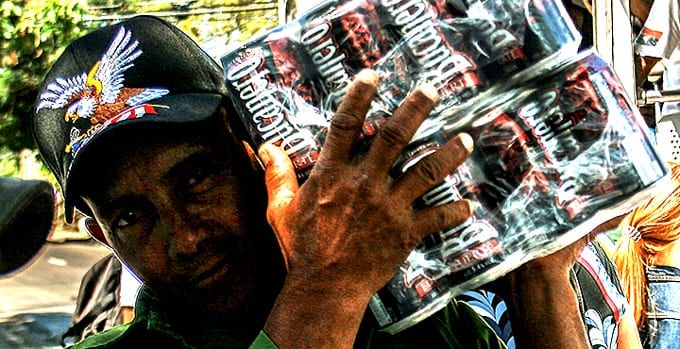Beer Shortages in Cuba with More Tourism

HAVANA TIMES — Beer drinkers in Cuba have been on edge since the press acknowledged the domestic industry’s inability to satisfy the growing demand for the product at State hard currency stores and private businesses, a situation now coupled with the tourism boom.
The opinions expressed on the street range from indifference – “Who cares, as long as a beer costs 25 pesos and I continue to earn 400 a month, I’ll never be able to afford it,” a man from Sancti Spiritus says – to dissatisfaction, a reaction that becomes increasingly common as the regular peso market continues to experience shortages and the hard currency one becomes unstable.
“I just saw the owner of a restaurant load his car up with beer case after case,” says Agustin Romero, from Sancti Spiritus. “Then, I go into the store and what do they tell me? That they’ve run out. Makes sense, I hadn’t gone with thousands of pesos to buy in bulk, I’d gone to buy three measly beers.”
This scenario is also common in Havana, where our reporters have spotted trucks full of Cristal-brand beer take a detour away from the sales point – where not even a single can is unloaded – and head straight for an address that the owner of a Lada car hands over to the driver along with a generous payment.
Some time ago, in a report that investigated the lawlessness of certain private bars and discos, some of the owners interviewed told of their maneuvers to ensure their locales had a steady supply of beer. “It’s one of the most widely consumed products and I have to buy it in Cuban Convertible Pesos (CUC) like everybody else, transport it, refrigerate it and spend money on fuel to pick it up,” one of them said. These strategies, in addition to the illegality that these establishments claim to be “forced” into, as most pay those who work in State warehouses to put away products for them, involve “solidarity” networks that enable hoarding.
In Santiago de Cuba, the truck driver who transported Cristal-brand beer denied this, saying everything was business as usual and that domestically-produced beers (Cristal and Bucanero, that is) hadn’t gone out of circulation. “Look, my brother is coming from the United States and I want to buy some from you to have some in the house,” the reporter told him.

It was only in the Pan.com coffee shop on Aguilera Street that he was able to find these brands. At the Santiago de Cuba Casa del Caribe, where there is a sales point, they were only selling Presidente and other imported brands that cost more than 1 CUC. One of the barmen said he hadn’t seen Cuban beers for a long time and that it was normal for them to disappear like that.
“If you want your brother to drink beer, buy it now,” one of the clerks at La Bombonera told him. The clerk claims that it’s common for someone to come along and buy the entire stock of bottled Cristal-brand beer, and that the same was true of juices. “It’s not like before,” she said, referring to shortages that have become common.
Perhaps those who were loading the beer truck in Santiago de Cuba were sincere when they said there was nothing out of the ordinary with the supply. In Cuba, “normal” is any offer below the demand.
Toursim and the Self-Employed
“The times when beer collected dust in warehouses are behind us,” Mario Duañona, employee for the Provincial Food, Lodging and Recreation Company, says, explaining that the offer has not gone down but that demand has gone up.
“Cristal and Bucanero literally fly,” says Samy, who works at one of Las Tunas’ Caracol establishments. He and people from other provinces claim that shortages are owed to the increase in the number of private restaurants and rentals, which tend to hoard these products, having greater purchasing power. At root, there are two main forces at work: a vertiginous increase in the number of tourists visiting the entire island (in 2015, Cuba saw the record figure of 3.5 million visitors) and the domestic industry’s inability to increase production.
In 2014, Bucanero’s inability to meet domestic demand became evident. By the middle of that year, the company acknowledged having “experienced production problems owed to delays in the import of raw materials needed for production: the malt, which comes from the Czech Republic.” The production process, he added, requires a cycle of a minimum of 23 days, from the time the raw materials are received to the moment the beer is ready for bottling. Following this, the beer is distributed and sold.”
“The Coralsa Corporation and the Bucanero S.A. joint venture recognize they did not offer the public timely information regarding production and shortages in the market,” Yolanda Caceres Rodriguez, president of Coralsa, said at the time.
“On the one hand, we are obliged to sell to most of the self-employed, who still do not have a wholesale market they can go to, and, on the other, we have to keep our store chains supplied for customers wanting one or two cans,” Hiyalin Menendez Leon, from the Grupo Empresarial de Comercio de Sancti Spiritus, explains, concluding with a fact very few people openly acknowledge: “We are trying to fight the battle at these two fronts, but, in the end, we’re between a rock and a hard place.”

This is coupled with the fact two beer factories have ceased operations because of repair and maintenance (Caballos, in Ciego de Avila, and Manacas, in Villa Clara), the main suppliers of bottled beer sold in Sancti Spiritus and other provinces.
According to Menendez Leon, they’ve been fortunate because the plant in Camaguey is trying to meet the bottled beer needs of Sancti Spiritus has at the moment (though this temporary solution seems more of bandaid than a cure. “No way, the expert maintains “there’s no way to satisfy the public and private business owners at the same time, much less in July and August, when the summer says ‘here I am.’”
The months of July and August in 2015 cost the country more than 10 million dollars, as Cuba had to import beer in order to maintain basic supplies. And this was only in Havana, as a Ministry of Foreign Trade official was heard say, informally.
Today, not even in the highly hypothetical case that the shut-down factories began to operate and joined the current production infrastructure would there be enough beer. It is therefore not at all crazy to assume imports may continue to grow.
At hard currency stores, the situation is no less worrying. Not a single Cristal-brand beer were to be found in dozens of stores in Sancti Spiritus, Santiago de Cuba, Las Tunas and Havana last week.
At Guantanamo’s Bucanero bar, they’ve only been offering Bucanero on tap, dispensed in three-liter jars sold at 7.50 CUC, some 187 Cuban pesos. According to one of the barmen, Atonio Foester, the supply of other Cuban beers commonly sold there, Mayabe, Bucanero and Cristal, ran out nearly month ago.
All the while, beer is not a problem at hotels belonging to Cuba’s Islazul chain in Guantanamo. At the Marti, located in the downtown area, the ones most commonly sold to the public, at the higher price of 1.15 CUC, and imported beers such as Bavaria and Heineken. This suggests imbalances and even illegalities in the distribution of the product, as the manner this situation has been handled and the prices (which fluctuate in private establishments) suggest.
With the collaboration of journalists Gisselle Morales, Istvan Ojeda Bello, Carlos Melian, Lilibeth Alfonso and Rachel D. Rosas.
Cover photo: Lilibeth Alfonso.






Beer provides the classic demonstration of Cuba’s economic problems. Here was a country with a virtual monopoly of beer production. So taking Bucanero and Cristal as examples because many tourists enjoyed them as well as Cubans, supply was reduced. Eventually this necessitated the introduction of Heinekin from Belgium, then Corona from Mexico, then Presidente from Dominica, then Bavaria from Holland. Thus Cubans working in the Cuban breweries had less work and those involved in the supply chain (constituents cans, bottles, labels etc.) had lower production and less work) as production was in reality transferred to capitalist economies. Marino Murillo the Minister responsible s supposedly a professional economist and he lectured the recent 7th Congress delegates and invitees about his intentions rather than explaining his evident incompetence.
Back in 1989, Fidel Castro wrote of how when flying over Sancti Spiritus he looked down and imagined 150 100 cow dairy herds and that he would build them. The Castros as communists never lacked ideas, just the ability to pursue them. Communism has always excelled at producing five year plans and then when they inevitably fail to reach fruition, to hold a congress or ‘parliament’ to provide fatuous excuses. When the regime cannot even supply toilet paper, why expect it to produce fresh milk – which is supposed to be available to age 7.
While Raul referenced milk 29 times in that speech, I simply cannot find any place where he suggested the possibility of a glass of milk for every Cuban on every Cuban table.
With respect, you are wrong. I was there at the time, in Camaguey, in 2008, where Raul Castro in a speech suggested the possibility of a glass of milk for every Cuban on every Cuban table.
Cuba has always had beer shortages, just like every things else. This is nothing new.
I don’t think it has that much to do with tourism. I am the only foreigner where I live part time and most of the beer sold is Mayabe and Cacique. Yet, there are shortages. One little stand, just down the street, basically only sells Cacique and nothing else. No other products, just beer and that is just Cacique. But they ran out 30 December and had nothing to sell until 5 January.
I believe it is the production and distribution systems much more than more tourists. But creation of a legitimate wholesale distribution system would go a long ways to resolving many of the distribution problems.
Thanks so much Circles! This makes it very clear — for the consumer market at least
So I see I need to learn what key items used to cost and how available they were i have so much to learn but I’ll be back soon and make sure to visit at least one place outside the capital. for some time
I have more thoughts and questions on Cuba v the USSR but I’ll save them now and speed up my learning from both reality and data, however questionable
What a treasure HT is! What
You are correct that the worker that earns in CUP can now use these to purchase in what were CUC only stores. I think people continue to note the difference because their salaries are paid in CUP and the CUC is pegged to the US dollar. In other times past 25 CUP bought a lot of beers. Now it buys one. That is, the prices are geared to the foreign currency value, while the buying power of wages has continued to decline. So the average worker can now buy one beer with a full day’s wage.
I wonder if the experts here can explain the reason they speak of hard.currency stores and a separate CUC and CUP market. I was only in Havana recently but to my surprise the difference was ‘just’ the exchange rate between them. Shops, even fancy ones in hotels posted notices ‘we take CUPs’ or MN
At least on shop had dual price stickers
There is a printed conversion chart in many places
Is this new? Is it good or bad for the average Cuban? Different outside the capital?
It isn’t what this article suggests at any rate.
As former expert on the Soviet economy and its shortages I am trying to grasp the differences and similarities with Cuba now.
It wasn’t Raul, was Fidel. Until recently beer has always being more difficult to find than milk.
From my experience Cuba imports beer from a number of Companies in Europe and D.R. – P.R – C. R. – Mexico.
Raul promised a glass of milk on every table. He can’t even keep the beer in supply to meet demand?